Overview
The article examines the pivotal role and benefits of fan wall units in data center operations, emphasizing their superior efficiency in temperature regulation and energy conservation. It articulates how their innovative design promotes optimal airflow, minimizes energy consumption through variable speed controls, and bolsters reliability with integrated redundancy. These features position fan wall units as the preferred choice over traditional cooling systems, underscoring their significance in modern data center strategies.
Introduction
Fan wall units have emerged as a pivotal innovation in data center operations, fundamentally transforming the management of temperature and airflow within these critical environments. By leveraging advanced technology and strategic design, these systems enhance energy efficiency and ensure the optimal performance of IT equipment. As the demand for cooling solutions escalates amidst increasing power densities, a pressing question arises: how can engineers effectively harness the benefits of fan wall units while navigating the complexities of maintenance and operational efficiency?
This article delves into the intricacies of fan wall units, exploring their functionality, advantages, and essential upkeep practices that engineers must consider to optimize their data center operations.
Define Fan Wall Units and Their Role in Data Centers
Fan wall unit data center systems represent advanced temperature regulation solutions specifically designed for managing conditions in data centers. Comprising multiple blowers arranged in a grid layout, these systems are typically installed along the perimeter walls of the data center. This strategic configuration enables efficient intake of hot air from the environment and the expulsion of cooled air back into the data center. Their primary function is to sustain optimal temperature and humidity levels, thereby ensuring the reliability and performance of critical IT equipment. By integrating the fan wall unit data center into the design, engineers can achieve superior airflow management and energy efficiency compared to traditional temperature regulation methods.
Gagner-Toomey Associates, recognized as the world’s largest manufacturer of standard and custom air-movers, provides a comprehensive product line of DC input tube axial fans and centrifugal blowers, all optimized for performance, efficiency, and low noise. The market for fan partition temperature control systems is projected to grow at a CAGR of 7.2% from 2025 to 2033, reaching an estimated market size of USD 4.62 billion by 2033. Notably, the Asia Pacific region is anticipated to experience even more rapid growth, with a CAGR of 9.1% during the same timeframe. Currently, North America leads the fan system market, particularly in the United States, where the demand for effective temperature regulation is pronounced.
Recent advancements in technology for the fan wall unit data center, such as smart controls and modular designs, further enhance performance and adaptability, solidifying their status as a preferred choice for contemporary data centers. Gagner-Toomey’s extensive portfolio encompasses solutions tailored for various applications, ensuring that engineers have access to the appropriate tools for their specific cooling needs.
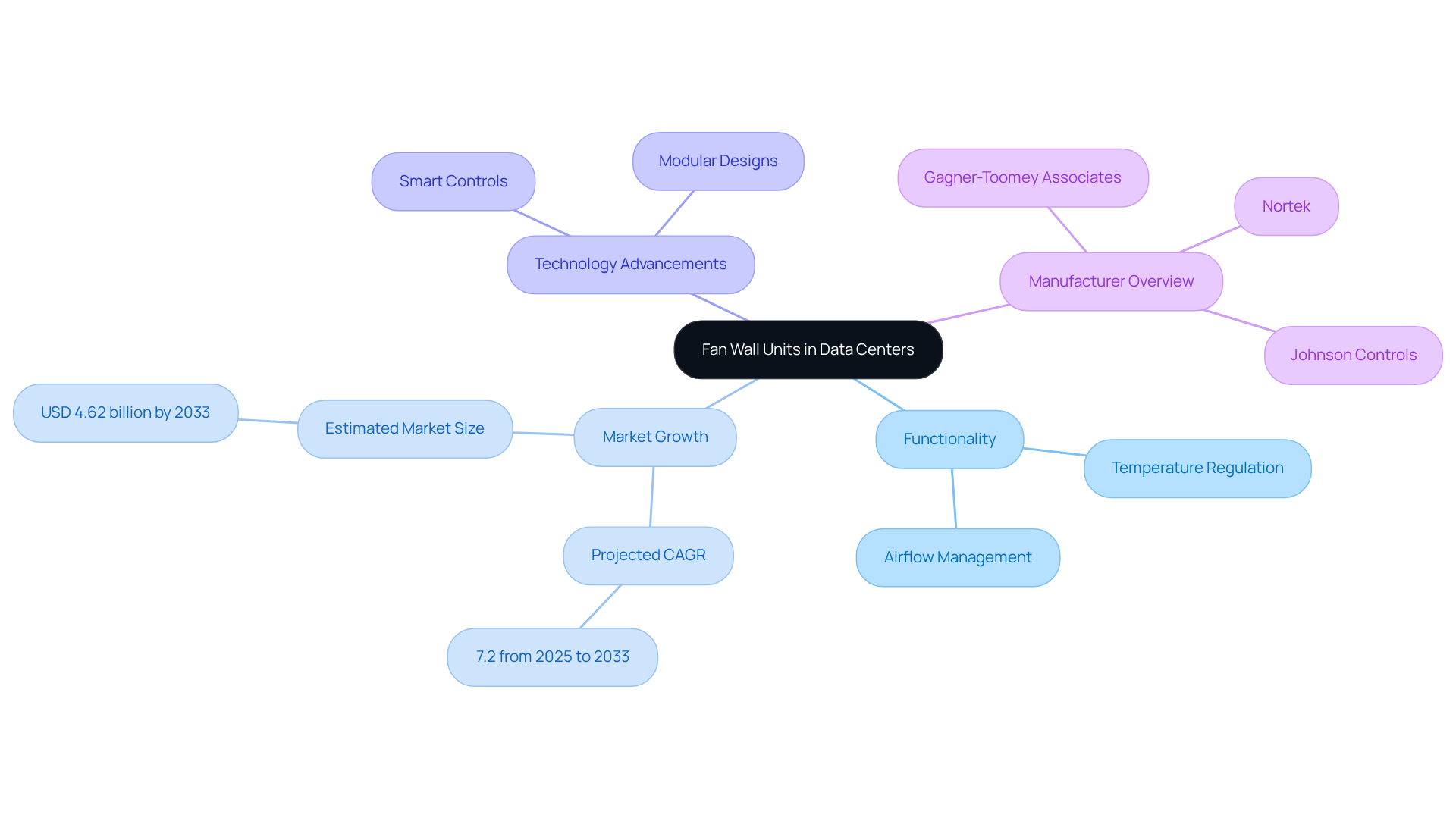
Explain How Fan Wall Units Operate in Data Centers
The fan wall unit data center operates by utilizing a series of compact, high-efficiency blowers that work in unison to create a consistent airflow throughout the facility. These fans are typically equipped with variable speed drives, allowing them to adapt their speed based on real-time temperature and humidity readings. This dynamic operation is crucial for maintaining a stable environment, leading to reduced energy consumption and enhanced cooling efficiency.
According to Vertiv, studies indicate that:
- A 10% reduction in fan speed can yield energy savings of up to 27%.
- A 20% reduction can achieve savings of 49%.
Furthermore, the design of fan assemblies minimizes noise and vibration, with brushless DC motors ensuring quieter operation and extended lifespans, thereby fostering a more favorable working environment for sensitive electronic devices. Additionally, the modular design of these components facilitates effortless scalability, addressing the evolving requirements of data centers.
As the demand for effective temperature management escalates, fan wall unit data centers are becoming a preferred solution, with reports underscoring their ability to decrease operational expenses and enhance sustainability efforts. This is exemplified by case studies, such as that of a global textile producer that successfully lowered energy costs and carbon emissions through the implementation of energy-efficient technologies.
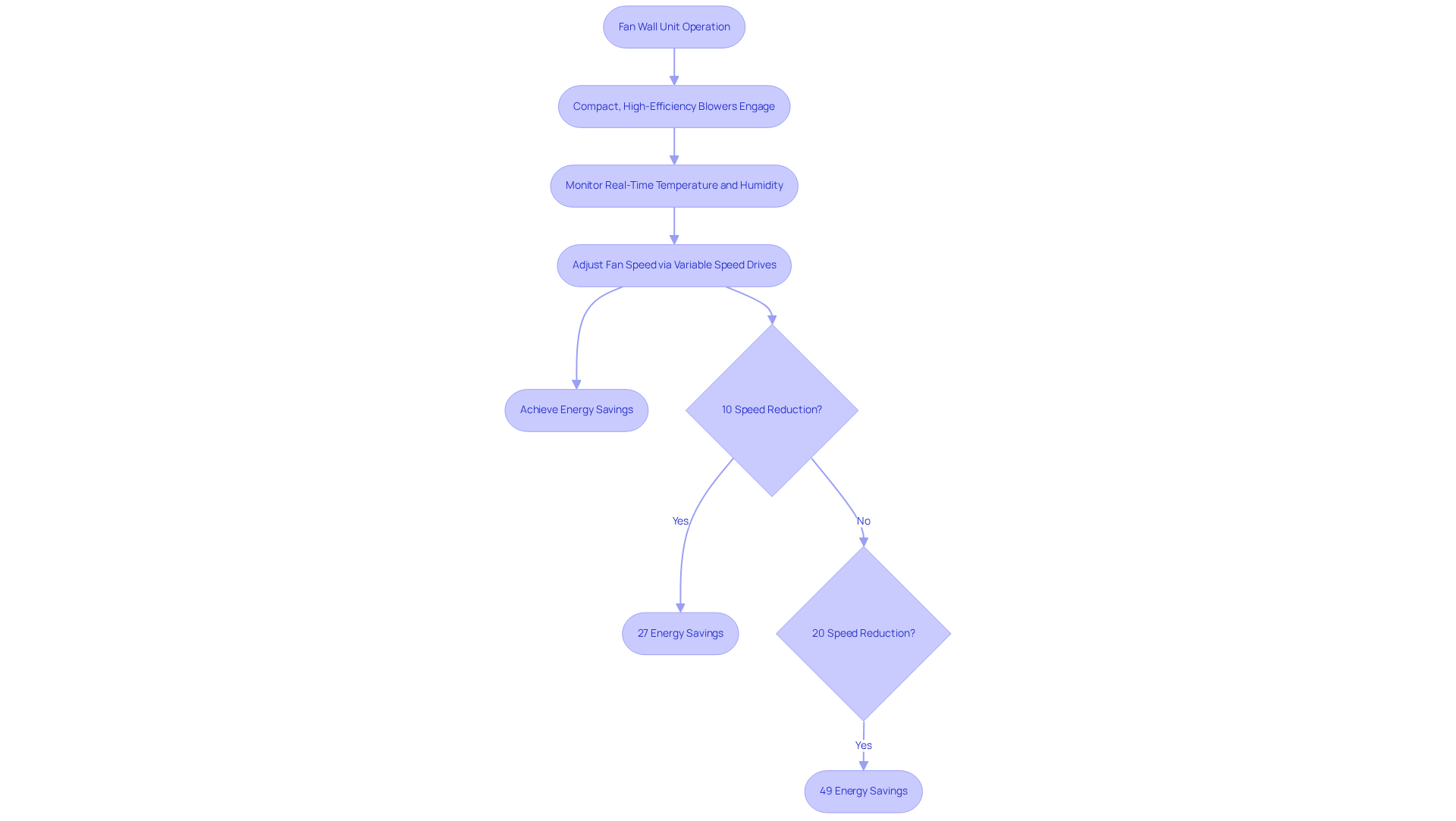
Identify Key Components and Features of Fan Wall Units
Key components of fan wall units are critical for optimizing performance and efficiency:
- Fans: By utilizing multiple smaller fans rather than a single large fan, airflow distribution is significantly enhanced. This design not only provides redundancy—ensuring consistent cooling even in the event of a fan failure—but also leads to energy savings of 7% to 15% compared to traditional systems. Smaller fans operate more efficiently than their larger counterparts, making this an advantageous choice.
- Control Systems: Advanced control systems, featuring technologies such as EC motors and variable speed control, are integral to the operation of fan wall units. These systems actively monitor temperature and humidity levels, adjusting fan speeds in real-time to optimize performance. This capability ensures that the ventilation capacity in the fan wall unit data center aligns with demand, which is essential for maintaining stable conditions.
- Filters: High-efficiency filters are incorporated to uphold air quality, shielding sensitive equipment from dust and debris. This feature is crucial for extending the lifespan of IT infrastructure, as clean air minimizes wear and tear on components, thereby enhancing operational reliability.
- Dampers: These components are essential for regulating airflow and preventing backdrafts, contributing to the overall efficiency of the cooling system. Proper damper functionality is vital for sustaining optimal airflow patterns, which is critical in high-performance environments.
- Mounting Frames: Designed for ease of installation and maintenance, these frames securely support the fans and other components, facilitating straightforward access for servicing. The modular structure of fan assemblies allows for scalability and adaptability to various room dimensions and site conditions, enhancing their versatility.
Collectively, these characteristics significantly improve temperature regulation efficiency, promote energy conservation, and ensure operational dependability in fan wall unit data centers. Consequently, fan array systems emerge as a robust solution for contemporary temperature control challenges.
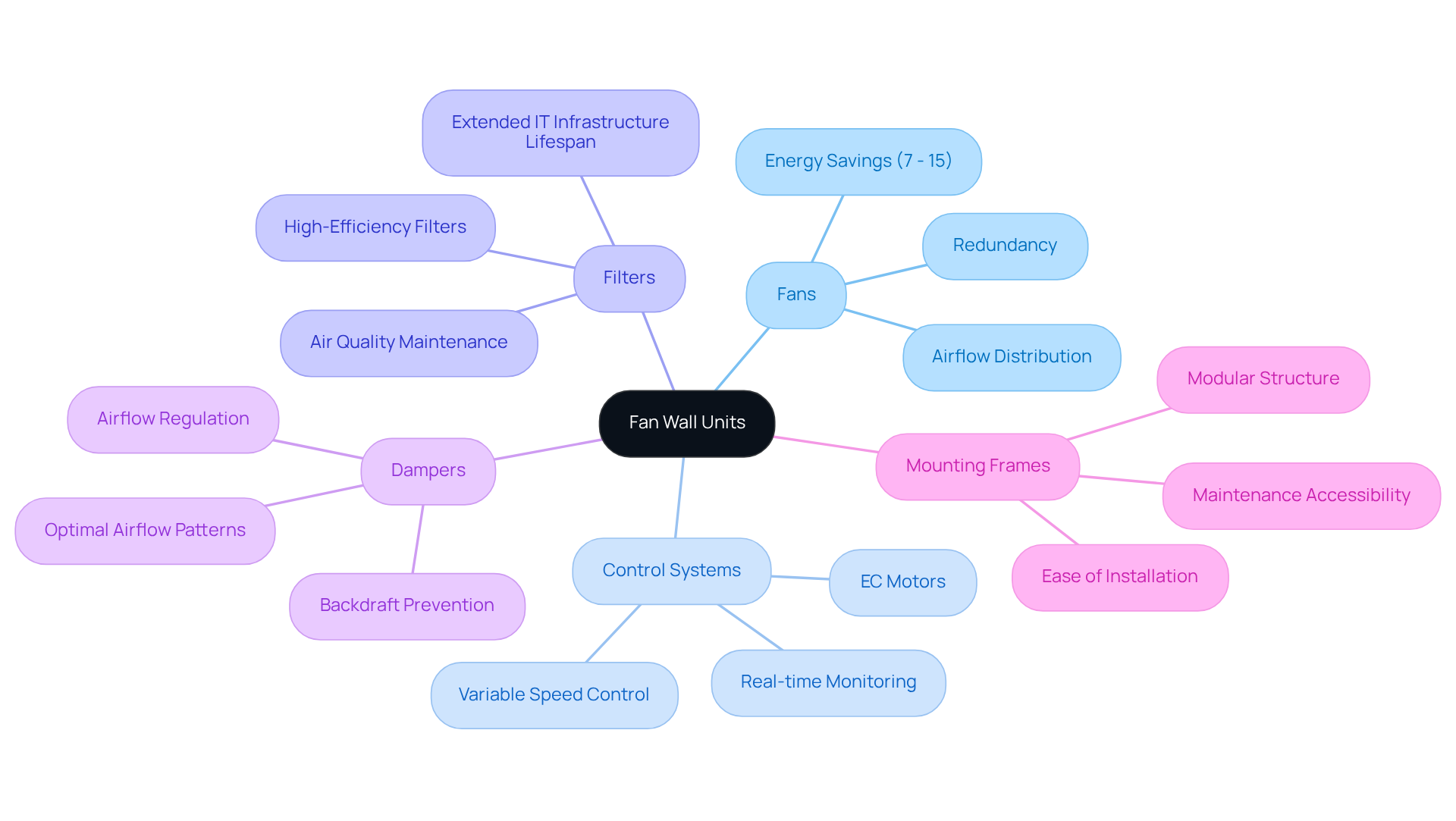
Compare Benefits of Fan Wall Units to Traditional Cooling Systems
Fan wall unit data centers offer significant advantages over traditional cooling systems, making them an increasingly popular choice in modern facilities.
-
Energy Efficiency: Fan wall units are engineered to operate at variable speeds, potentially leading to energy savings of 20-30% in cooling-related power consumption. By utilizing EC fan structures, data centers can significantly reduce cooling-related power usage, resulting in substantial declines in energy expenses. Some studies indicate that these systems can achieve energy savings of up to 25% compared to conventional setups.
-
Space Optimization: Their modular design facilitates installation in confined spaces, thereby maximizing floor area for additional equipment. This feature is particularly advantageous in high-density computing environments where every square foot is critical.
-
Redundancy: With multiple blowers incorporated, wall units ensure operational continuity. In the event of a fan malfunction, others continue to function, providing reliable temperature regulation without interruption. This reliability is essential for maintaining optimal data center performance.
-
Enhanced Airflow Management: The grid layout of air circulators fosters a more uniform airflow distribution, effectively reducing hot spots within the data center. This improved airflow management can lead to a decrease in temperature differentials between racks, thereby enhancing overall cooling efficiency.
-
Lower Noise Levels: Smaller fans typically operate more quietly than their larger counterparts, contributing to a more pleasant working environment for staff.
Moreover, retrofitting to a modular EC fan structure represents one of the highest-ROI enhancements available, underscoring the financial benefits of transitioning to fan systems. Approximately 35% of a data center’s energy consumption is attributed to HVAC systems, highlighting the necessity of improving temperature regulation solutions. These advantages elucidate why installations of fan wall unit data centers are favored in modern data centers, especially those facing the challenges of increased power densities and the demand for effective cooling solutions.
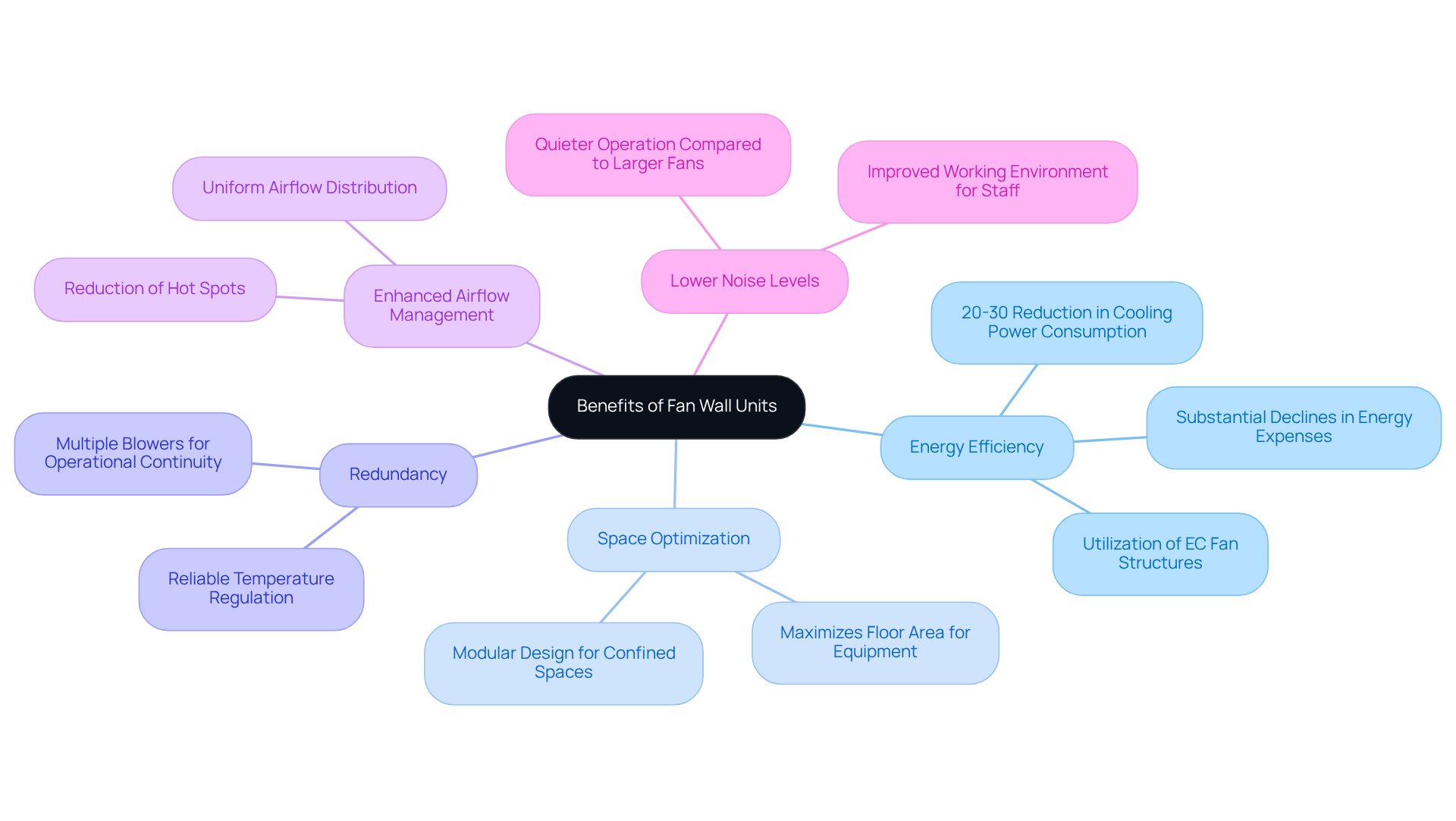
Outline Maintenance Practices for Fan Wall Units
To ensure optimal performance and longevity of fan wall units, it is essential to implement the following maintenance practices:
- Regular Cleaning: Clean fan blades, filters, and surrounding areas to prevent dust accumulation, which can significantly hinder airflow and efficiency. Regular cleaning can improve airflow by 10-46% and reduce energy consumption by 41-60%. Furthermore, poorly insulated rooms or inadequate ventilation increase the workload on fan wall units, making regular cleaning even more critical.
- Inspect Components: Conduct routine inspections of ventilators, control systems, and electrical connections to identify signs of wear or damage. Common mechanical issues include unbalanced fan blades and loose components. Scheduled inspections help detect issues early, reducing the likelihood of unplanned downtime by up to 66%.
- Monitor Performance: Utilize advanced monitoring systems to track critical parameters such as temperature, humidity levels, and vibration. Sensors installed on fans provide real-time data on these parameters, allowing for adjustments to maintain optimal conditions and ensure cooling capacity aligns with demand.
- Schedule Professional Inspections: Engage skilled technicians for periodic inspections to identify potential issues before they escalate. Planned evaluations include expert examinations of elements such as fan blades and motors for deterioration or imbalance, which can prolong the operational lifespan of fan systems and avert expensive repairs.
- Document Maintenance Activities: Maintain detailed records of all maintenance activities to track performance trends and inform future maintenance schedules. This documentation is crucial for benchmarking against industry standards and optimizing maintenance strategies, helping to identify recurring issues.
By adhering to these practices, engineers can ensure that fan wall unit data center operations function efficiently and effectively, significantly contributing to the overall reliability and performance.
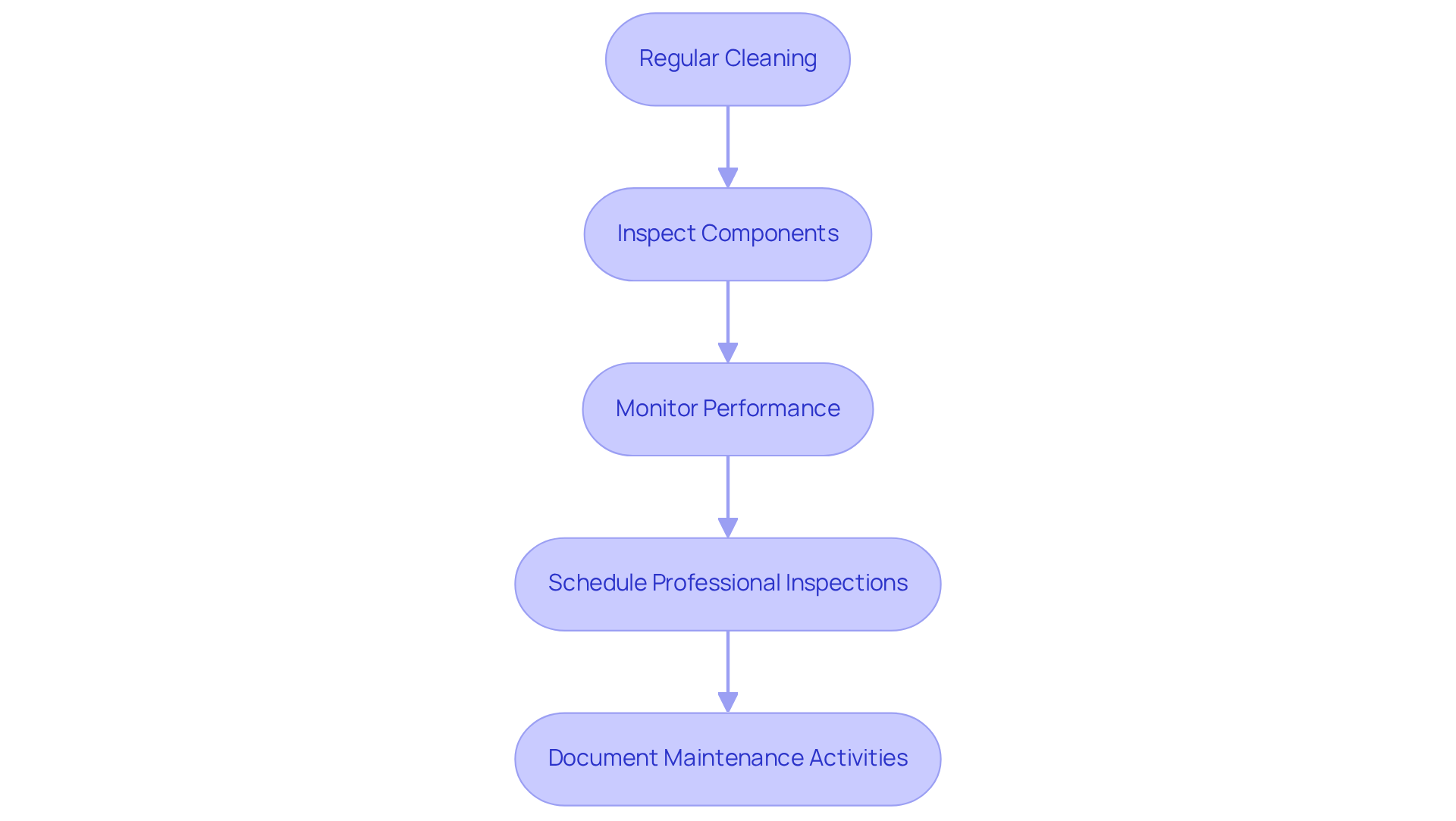
Conclusion
Fan wall units are essential to the operations of modern data centers, delivering sophisticated solutions for temperature regulation and energy efficiency. These systems, characterized by a grid layout of multiple blowers, not only improve airflow management but also safeguard the reliability of critical IT equipment by maintaining optimal temperature and humidity levels. As data centers encounter escalating demands for effective cooling solutions, the adoption of fan wall units emerges as a proactive strategy for managing environmental conditions.
Key insights throughout this article have illuminated the operation, components, and advantages of fan wall units. From their energy-saving capabilities and modular design to the necessity of regular maintenance practices, it is clear that these systems surpass traditional cooling methods in numerous respects. The integration of advanced technologies, such as variable speed drives and intelligent control systems, further emphasizes their role in optimizing data center performance while reducing operational costs.
Given the increasing demand for efficient cooling solutions in data centers, embracing fan wall unit technology is not merely a preference but an imperative. As the industry progresses, engineers and facility managers are urged to investigate the potential of these innovative systems to bolster operational reliability and sustainability. By prioritizing the incorporation of fan wall units, data centers can enhance their cooling efficiency while also contributing to long-term energy conservation and cost reduction, thereby paving the way for a more sustainable future in IT infrastructure.
Frequently Asked Questions
What are fan wall units and their purpose in data centers?
Fan wall units are advanced temperature regulation systems designed for data centers, consisting of multiple blowers arranged in a grid layout. They are installed along the perimeter walls to efficiently intake hot air and expel cooled air, maintaining optimal temperature and humidity levels for critical IT equipment.
How do fan wall units improve airflow management and energy efficiency?
By integrating fan wall units into data center designs, engineers achieve superior airflow management and energy efficiency compared to traditional methods, ensuring reliable performance of IT equipment.
What is the market outlook for fan wall units?
The market for fan wall units is projected to grow at a CAGR of 7.2% from 2025 to 2033, reaching an estimated size of USD 4.62 billion by 2033, with the Asia Pacific region expected to grow even faster at a CAGR of 9.1%.
What recent advancements have been made in fan wall unit technology?
Recent advancements include smart controls and modular designs that enhance performance and adaptability, making fan wall units a preferred choice for modern data centers.
How do fan wall units operate to maintain temperature and humidity?
Fan wall units operate using compact, high-efficiency blowers that create consistent airflow. They are equipped with variable speed drives that adjust based on real-time temperature and humidity readings, leading to reduced energy consumption and enhanced cooling efficiency.
What energy savings can be achieved by adjusting fan speeds?
A 10% reduction in fan speed can yield energy savings of up to 27%, while a 20% reduction can achieve savings of 49%.
How do fan wall units minimize noise and vibration?
The design of fan assemblies minimizes noise and vibration, utilizing brushless DC motors that ensure quieter operation and longer lifespans, creating a favorable environment for sensitive electronic devices.
Why are fan wall units becoming a preferred solution for data centers?
Fan wall units are favored due to their ability to decrease operational expenses, enhance sustainability efforts, and effectively manage temperature, as demonstrated by case studies of companies that reduced energy costs and carbon emissions with these technologies.

